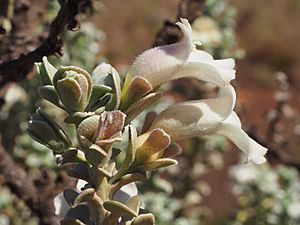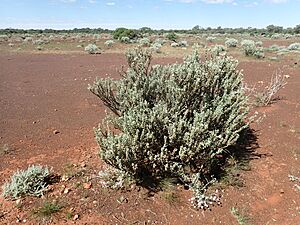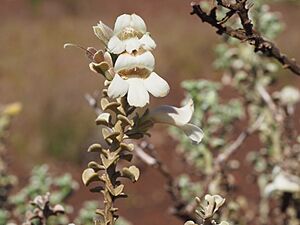Eremophila rigida facts for kids
Quick facts for kids Eremophila rigida |
|
|---|---|
 |
|
| Eremophila rigida leaves and flowers | |
| Conservation status | |
| Scientific classification | |
| Genus: |
Eremophila (plant)
|
| Species: |
rigida
|
Eremophila rigida is a cool flowering plant that belongs to the figwort family. It's special because it's found only in Western Australia. This plant is an upright, stiff shrub with thick, hairy leaves and pretty pale yellowish-cream flowers.
Contents
What Eremophila rigida Looks Like
Eremophila rigida is an upright, stiff shrub that usually grows to be about 0.5 to 1.2 metres (about 1.6 to 3.9 feet) tall. Its branches and leaves are covered in simple, silvery-grey hairs. These hairs can sometimes turn brown or reddish. The branches feel rough because of old leaf bases that stay on them.
The leaves grow one after another along the stem. They are thick, very stiff, and folded into a U-shape. Their shape can be like an egg or a kidney. Each leaf has a flat stalk that is about 3 to 6 millimetres (0.1 to 0.2 inches) long. The leaf blade itself is about 9 to 14 millimetres (0.4 to 0.6 inches) long and 8 to 16.5 millimetres (0.3 to 0.6 inches) wide.
The flowers grow one by one where the leaves meet the stem, on stalks that are 6 to 8 millimetres (0.2 to 0.3 inches) long. There are 5 cream-coloured, overlapping, hairy sepals (these are like small leaves that protect the flower bud). They have a greenish tint but turn reddish-brown after the flower blooms. The sepals are different shapes and are about 9 to 13 millimetres (0.4 to 0.5 inches) long.
The petals are about 23 to 26 millimetres (0.9 to 1.0 inches) long and are joined together at the bottom to form a tube. This petal tube is cream-coloured, sometimes with a light purple tint on top. The outside of the petal tube and its tips are hairy. However, the inside is smooth, except for part of the bottom tip and the inside of the tube, which is full of long, soft hairs. The 4 stamens (the parts that make pollen) are completely hidden inside the petal tube.
This plant flowers from June to September. After flowering, it produces broad, oval-shaped fruits that are about 5.5 to 7.5 millimetres (0.2 to 0.3 inches) long and covered in hairs.

How Eremophila rigida Got Its Name
This plant was officially described for the first time by a scientist named Robert Chinnock in 2007. He published his description in a book called Eremophila and Allied Genera: A Monograph of the Plant Family Myoporaceae.
The second part of its scientific name, rigida, comes from a Latin word. It means "stiff," "rigid," "hard," or "inflexible." This name was chosen because of the plant's stiff leaves.
Where Eremophila rigida Lives
Eremophila rigida grows in open areas on stony clay flats. You can find it between the towns of Meekatharra and Newman in Western Australia. These areas are part of the Gascoyne and Pilbara biogeographic regions.
Looking After Eremophila rigida
The Western Australian Government's Department of Parks and Wildlife has given this plant a special status called "Priority Three." This means that we don't know a lot about this plant, and it's only found in a few places. However, it's not in immediate danger of disappearing.
Growing Eremophila rigida in Gardens
People like to grow Eremophila rigida in gardens because of its unusual, stiff leaves and the many flowers it produces in spring. The best ones to grow have yellow buds that open into beautiful cream-coloured flowers.
This plant is usually grown by grafting. This is a method where a part of the Eremophila rigida plant is joined onto the rootstock (the root system) of another plant, often a Myoporum. It grows best in sunny spots with soil that drains water well. It can handle dry periods, needing only one or two deep waterings during a long dry spell. However, it's not very good with strong frost.



